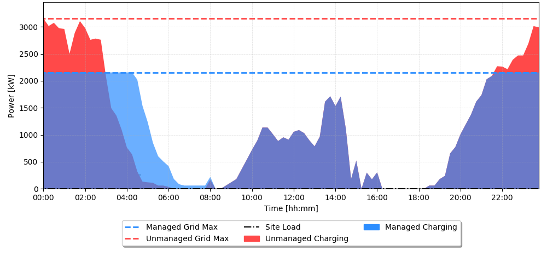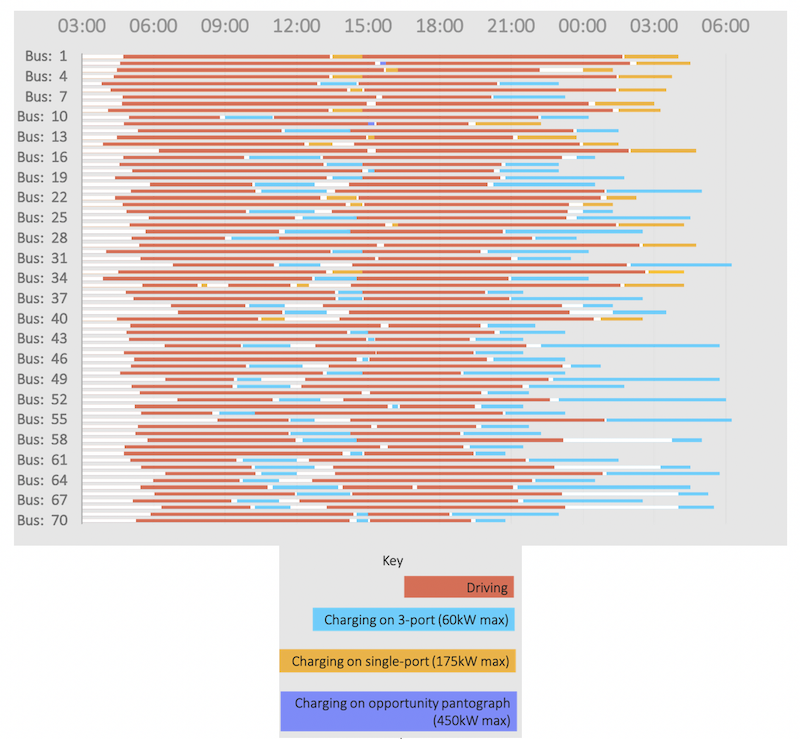2020 to 2043 on highway and white marking lines in the forest, Happy new year and road to success concept

Fleet Owners: For Big Savings, Plan Now for Electrification
Today, most fleets are at an early stage of EV adoption and their approach is incremental, e.g. buy a few vehicles and a few chargers each year. In our recently-released report Steep Climb Ahead, we recommend that fleet managers instead develop a long-term plan that incorporates how many vehicles and chargers (and what types of chargers) will be purchased annually as well as where and when vehicles will be charged.
Today’s incremental approach works for now but will quickly incur excessive capital costs and reduce operational costs savings for the fleet. Although a long-term plan requires more upfront effort, it is a superior approach that will only benefit a fleet’s bottom line.
In this blog, the second in a series following the release of our report Steep Climb Ahead, we dig deeper into important issues that fleet managers will have to address as they scale their fleet’s electrification. Here, we look more closely at key component of a long-term fleet electrification plan, in particular:
- Deciding on the ratio of vehicles to chargers (and charger types) and futureproofing the fleet depot to minimize costs for future installations and
- Developing an energy and charging management strategy
Our partner for these blogs, The Mobility House, is providing real-world examples from their extensive experience in this space.
Deciding How Many Chargers and What Types to Purchase
One of the most important parts of a long-term fleet electrification plan is to determine how many chargers and what types will be installed and when. When a fleet only has a few vehicles, they will likely only need Level 2 chargers. With more vehicles, fleets may need DC fast charging not only to accommodate fleet charging needs and schedules but also for driver convenience. Getting the number and type of chargers right will ensure a smooth transition to EVs with little disruption to operations while minimizing infrastructure costs and fully utilizing the charging infrastructure.
The Mobility House recently consulted on a project for a public transit operator to electrify a fleet of 70 buses, including understanding the number of chargers that would be required at their depot. Many fleet owners assume they need to purchase one charger for every vehicle and over-invest in infrastructure. But infrastructure requirements are highly dependent on fleet schedule as well as vehicle and charger specifications. Depot sizes also impose space constraints that limit equipment on-site.
For this project, the customer initially planned to install 20 fast chargers and two on-route opportunity pantograph (overhead) chargers. After The Mobility House’s analysis, the public transit operator was able to reduce upfront costs by installing only fourteen 175 kW chargers and one 450 kW opportunity charger while still meeting the fleet’s requirements.
The Mobility House also provided a charging and energy management strategy to minimize operating expenses—including when to swap vehicles around the yard—and to flatten overnight charging load for optimizing an onsite generator. The depot chargers are to be installed in three phases with a recommended plug time schedule for each phase that allows for optimized charging to continue as new buses are added, as shown in Exhibit 1.

One of the most significant benefits of having a long-term plan in place (i.e., knowing the number and types of chargers needed and how they will be phased) is that a fleet manager can “futureproof” the site when installing the first phase of charging stations. That is, during the first phase, they can install all of the wiring and utility-side electric infrastructure required for all future chargers. This means that, for future installations, all that needs to be done is to plug in the charger rather than incur expensive trenching costs during each phase.
Developing an Energy and Charging Management Plan
As noted in the above example, in addition to future-proofing a site, developing a charging and energy management strategy is a critical next step for fleet managers.
The Mobility House worked with the Center for Transportation and the Environment, Schneider Electric, and Sage Energy Consulting on a California Air Resources Board grant project to deliver a smart charging and operations strategy for Stockton Unified School District (SUSD). This project utilized make-ready infrastructure from Pacific Gas & Electric (PG&E) to provide a second meter at the site for the EV chargers, qualifying the customer to participate in PG&E’s business electric vehicle rate.
When it comes to charging, a common misconception among fleet operators and drivers is that each vehicle must be immediately plugged in every time it returns to the depot in order to ensure it is ‘fueled’ for the next drive. In reality, fleet charging depends on many factors including fleet schedule and vehicle and charger specifications. Varying local utility tariffs further compound this complexity and can be difficult to navigate for operators looking to improve the cost effectiveness of their charging.
To minimize electricity charging costs and ensure SUSD’s vehicles are available for assigned routes, The Mobility House used fleet schedules, hardware requirements and local utility rates to simulate charging operations. With SUSD’s 11 school buses utilizing four 50 kW DC fast chargers and ten 16.8 kW Level 2 chargers, The Mobility House concluded that SUSD has sufficient charging capacity to operate electric buses for even its longest daily routes.
The Mobility House then used its charging and energy management solution, ChargePilot, to optimize charging around PG&E’s time-of-use rate, reducing peak charging during the school year (shown in Exhibit 2) from more than 317 kW to approximately 79 kW. This saved $25,700 per year in electricity costs. During the two months of summer, SUSD can reduce charging peak from 199 kW to 77.8 kW, saving an additional $5,600 per year. These results yield over a 57 percent reduction in SUSD’s total annual electricity costs, greatly improving the electric fleet’s economics.

SUSD plans to expand its fleet to 24 electric buses, so The Mobility House also generated scenarios for their future charging schedule. These projected more than $98,000 per year in charging cost savings. The work with SUSD clearly demonstrates that as fleet operators scale their EV operations, smart charging and energy management is critical for realizing the cost benefits of EVs and ensuring no disruptions to operations.
Our report, Steep Climb Ahead, found that fleet managers electrifying their fleets are particularly concerned about avoiding disruptions to operations and reducing costs. The two examples above showcase how putting in the upfront effort to develop a long-term fleet electrification plan can ensure just that: a seamless (and cheaper) transition to EVs.
About The Mobility House
The Mobility House mission is to create an emissions-free energy and mobility future. Since 2009, the company has developed an expansive partner ecosystem to intelligently integrate electric vehicles into the power grid, including electric vehicle charger manufacturers, 400+ installation companies, 40+ energy suppliers, and automotive manufacturers ranging from Audi to Tesla. The Mobility House’s unique vendor-neutral and interoperable technology approach to smart charging and energy management has been successful at over 500 commercial installations around the world. The Mobility House has 140 employees across its operations in Munich, Zurich and California.
